What Is An Anvil Used For
An anvil is a hard slice of metallic which is used as a workbench when making things out of iron or steel. An anvil is used by a blacksmith when he needs to hammer hot atomic number 26 to bend it into the shape he wants. A blacksmith can make new shoes for horses.
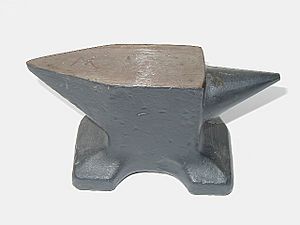
Anvils were known in the Bronze Age and possibly earlier. They were used in Ancient Greece and Aboriginal Egypt. They are still in utilize today, although non nearly as much as 100 years agone when there were many more horses.
Anvils are extremely heavy. They are fabricated in unlike sizes. The 17th century author John Bunyan was a tinker (someone who mends pots and pans). He walked around the villages of Bedfordshire with a minor anvil and a few tools on his back. His anvil was wedge-shaped, so that he could knock information technology into the ground when he needed to practice a repair. His anvil is now in the John Bunyan museum in Bedford.
Structure
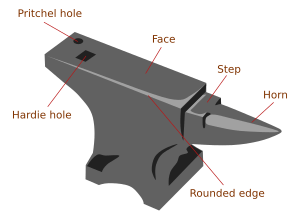
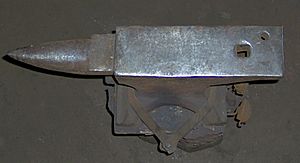
A superlative view of a well used London blueprint anvil
The primary work surface of the anvil is known as the confront. Information technology is more often than not made of hardened steel and should be flat and smooth with rounded edges for most work. Any marks on the face will be transferred to the work. Also, sharp edges tend to cut into the metallic being worked and may cause cracks to course in the workpiece. The face is hardened and tempered to resist the blows of the smith'southward hammer, so the anvil face does not deform under repeated use. A hard anvil face also reduces the corporeality of force lost in each hammer blow. Hammers, tools, and work pieces of hardened steel should never straight strike the anvil face with full force, as they may harm information technology; this can issue in chipping or deforming of the anvil face.
The horn of the anvil is a conical projection used to form various round shapes and is generally unhardened steel or iron. The horn is used more often than not in bending operations. It also is used past some smiths as an help in "drawing down" stock (making it longer and thinner). Some anvils, mainly European, are made with 2 horns, ane square and one round. Also, some anvils are fabricated with side horns or clips for specialized work.
The step is that area of the anvil between the "horn" and the "face". It is soft and is used for cutting; its purpose is to preclude damaging the steel face of the anvil past conducting such operations there and so as not to damage the cut edge of the chisel, though many smiths shun this practice equally it will damage the anvil over time.
The hardie hole is a foursquare hole into which specialized forming and cutting tools, called Hardy tools, are placed. It is as well used in punching and bending operations.
The pritchel hole is a small circular hole that is nowadays on most mod anvils. Some anvils have more than ane. It is used mostly for punching. At times, smiths volition fit a 2nd tool to this pigsty to permit the smith more flexibility when using more than one anvil tool.
Placement
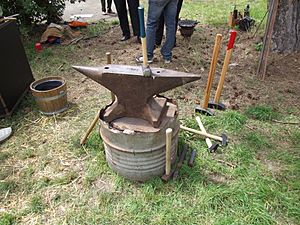
An anvil needs to be placed upon a sturdy base of operations made from an touch and fire resistant material. Information technology requires beingness attached firmly to the base of operations, so it will not move when struck with a hammer. A loose anvil is extremely unsafe, as information technology can fall off the base and is an ineffective forging tool. Common methods of attaching an anvil are spikes, bondage, steel or atomic number 26 straps, clips, bolts where there are holes provided, and cables. A smith would use whatever was at hand, as long equally it held the anvil firmly in place. The anvil is placed every bit near to the forge as is convenient, mostly no more than than ane footstep from the forge to forbid heat loss in the work piece.
The most common base traditionally was a difficult forest log or big timber buried several anxiety into the floor of the forge store flooring. This was washed to make the anvil immobile when heavy forging and bending were washed upon the anvil. In the industrial era cast iron bases became available. They had the reward of adding additional weight to the anvil, making it more than stable while making the anvil movable. These bases are highly sought afterward past collectors today. When concrete became widely available, there was a trend to make steel reinforced anvil bases by some smiths, though this practice has largely been abandoned. In more modern times many anvils accept been placed upon bases fabricated from steel, often a short thick section of a big I-Beam. In addition, bases have been made from dimensional lumber bolted together to class a large cake or steel drums full of oil-saturated sand to provide a damping effect. In recent times tripod bases of fabricated steel have become popular with some smiths.
Use as a instrument
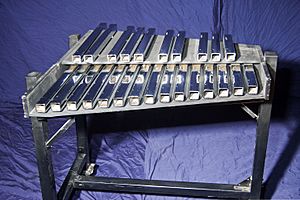
The anvil has sometimes been used as a percussion instrument because it makes a very loud sound when hitting by the hammer. Usually musicians use a metal bar mounted on a sound-box. This sounds but every bit good as a existent anvil (which would be very heavy to carry around).
Verdi wrote some famous music called the Anvil Chorus in his opera Il Trovatore. Wagner asked for 18 anvils in Das Rheingold in the scene which takes place beneath the globe where the Nibelungs are working at their forges. Johann Strauss II wrote an Anvil Polka, Varèse used an anvil in Ionisation, Walton uses an anvil in Belshazzar's Feast and there is an anvil in the orchestra in Howard Shore'south music for The Lord of the Rings movie trilogy.
- Forge
- Iron
- Steel
- Blacksmith
Images for kids
-

Anvil
-

An anvil at the medieval construction site of Guédelon in Treigny, French republic.
All content from Kiddle encyclopedia articles (including the article images and facts) can be freely used under Attribution-ShareAlike license, unless stated otherwise. Cite this commodity:
Anvil Facts for Kids. Kiddle Encyclopedia.
What Is An Anvil Used For,
Source: https://kids.kiddle.co/Anvil
Posted by: curranyoughthears.blogspot.com


0 Response to "What Is An Anvil Used For"
Post a Comment